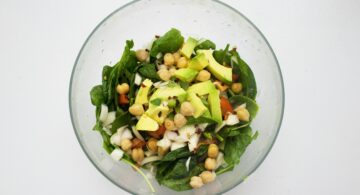Healing Lyme Disease With Foods
Nutrition for Lyme Disease Recovery
For those suffering from Lyme disease, what you eat can have a huge impact on your body, causing inflammation and a depressed immune system. Luckily, diet is something that’s within your control, and if you eat the right foods, you may see some of your most uncomfortable symptoms disappear.
To heal Lyme disease, you need to build a strong immune system, minimize inflammation and limit your intake of gluten. Here’s how you can achieve all these goals with a few simple diet modifications and some recipes to try at home.
Build a Strong Immune System
A healthy immune system is critical for Lyme disease patients because the bacteria that cause the disease have the ability to stop the immune system from launching a proper defense, according to research done at the University of California, Davis.While tests in the UC Davis study were done on animals, researchers concluded that this finding could answer the question of why Lyme disease patients are so vulnerable to multiple infections from the same strain of bacteria.
In order to stop multiple infections from happening, it’s important to focus on building your immune system, which will have a better chance at stopping the bacteria from infecting you again and again.
The role of nutrition is central not so much in the actual bug killing, but in the underlying strength and resilience of your health. Add the following foods to your shopping list to start building a healthier immune system:
Sweet Potato—High in Vitamin A
Vitamin A has been found to improve immune responses in animals, as well as children.
Sockeye Salmon—High in Vitamin D
Vitamin D works to improve and maintain neuromuscular and immune function.
Reduce Inflammation
Most inflammation symptoms related to Lyme disease are a cause of “inflammatory cytokines,” according to Dr. Bill Rawls. Luckily, diet can make improve the pain and inflammation you feel.
An anti-inflammatory diet heals the joint pain, swelling, fatigue, brain fog and headaches, and unhealthy cell function associated with Lyme disease.
Giving your body what it needs to fight inflammation includes eating:
Flaxseed—High in Omega 3
When broken down in the body, omega 3 works to reduce inflammation. Always buy ground flaxseed; whole flaxseeds don’t absorb as well in the body.
Spinach—Vitamin E
Not only is spinach loaded with omega 3s, but it’s also high in Vitamin E and B vitamins, all of which reduce inflammation in various ways within your body.
Limit Your Intake of Gluten
A large portion of the U.S. population is gluten intolerant, even if they don’t know it yet, because the human body has a hard time breaking down wheat. For some people, sprouted wheat is okay, because the sprouting process breaks down enzymes that are difficult to for our bodies to digest.
However, those suffering from Lyme disease are best to avoid gluten altogether. Fortunately, this is easier to do than you might think. There are many gluten-free products on the market, and a variety of delicious foods that can replace your usual gluten go-tos. Here are a few gluten free options to stock up on:
Food for Life Brown Rice gluten free bread
The texture and taste are better when toasted. Top with nut butter for a gluten free breakfast.
Brown Rice
Brown rice is naturally gluten free, and versatile. Add it to stir-fry or make it as a side for your chicken and vegetables.
Explore Asian bean noodles
These noodles are made with bean flour, so not only are they gluten free, but they’re high in fiber and protein. They taste like whatever they’re paired with, so you can make them with all your favorite noodle sauces including marinara and peanut.
With all these foods in your kitchen, it’s time to make a delicious meal. Try these two recipes to implement the Lyme diet in your everyday life.
Roasted Sweet Potato Salad
Ingredients:
- 2 sweet potatoes, diced
- 1-2 tablespoons EVOO oil
- 2 large sweet red peppers
- 1/2 lb fresh spinach, roughly chopped
- White balsamic vinegar
- Salt and pepper to taste
- Pepper
Directions:
- Sweet Potatoes: Preheat the oven to 450 degrees. Toss the sweet potatoes with the oil and gravy herbs. Spread on a greased baking sheet. Roast for 20 minutes – check the potatoes for doneness, gently stir, and return to oven. Repeat this process every five minutes for about 15 more minutes (total roasting time should be anywhere from 30-45 minutes). Turn up the heat to 475 and roast for a final 5-10 minutes to really brown them nice and pretty. When they’re done, they should be visibly browned and relatively “dry” to the touch so that once you loosen them you can shake the pan and they slide back and forth easily.
- Red bell peppers: Grill red peppers over medium heat for 10-15 minutes or until the skins blister, turning frequently. Immediately place peppers in a large bowl; cover and let stand for 15 minutes. Cut into slices.
- Assembly: Place roasted sweet potatoes and grilled red peppers over a bed of spinach and sprinkle with white balsamic vinegar.
- Serve this as side dish or add goat cheese and grilled chicken for a satisfying lunch.
Flax Seed Toast
Ingredients
- 2 slices gluten free bread
- 1 tablespoon almond butter
- 1 tablespoon organic jam
- 1 tablespoon ground flaxseed
Directions
- Toast your bread and top each one with half of the almond butter, jam and ground flaxseed. Enjoy this for breakfast or a hearty snack.
While the Lyme disease may feel impossible to cure, diet is something that’s within your control. With the right foods you can reduce major symptoms, such as inflammation and depressed immune system. Avoid highly pro-inflammatory foods like gluten, in favor of good fats like ground flaxseed. Add salmon and sweet potato to your weekly shopping list and you’ll begin to feel relief.
Healing is Possible. All you need is the right guidance, right foods and the information and support from Home Cures That Work.
If you liked this article, then you’ll love these:
- Gluten Intolerance: Going Against the Grain
- Foods to Calm and Lower Anxiety
- The Eating Plan Proven to Fight Inflammation



























